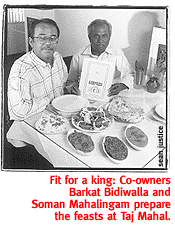
The Taj Mahal Restaurant Goes Easy On The Spices.
By Rebecca Cook
ALTHOUGH I FREQUENTLY can be found in the kitchen experimenting
with the latest new recipe, I usually shy away from dishes that
seem either too difficult or require the purchase of spices and
ingredients that are pricey and limited in their use to only one
particular dish.
 For this reason I've often avoided any serious attempt at mastering
Indian cooking. The complex blend of tastes, textures and spices
convinced me that volumes of time and vast stores of knowledge
were needed to create the taste of India.
For this reason I've often avoided any serious attempt at mastering
Indian cooking. The complex blend of tastes, textures and spices
convinced me that volumes of time and vast stores of knowledge
were needed to create the taste of India.
Fortunately, even though I don't concoct Indian delicacies at
home, I still have the option of tasting this cuisine any time
I want courtesy of the Taj Mahal restaurant.
The menu at the Taj Mahal is formidable and, if you're interested
in sampling Indian cuisine in any depth, you'll need to plan several
return visits. In fact, for the uninitiated, the many-paged menu
can be somewhat daunting. Where does one begin?
A good way to get your feet wet is to try Taj Mahal's daily luncheon
buffet. For $5.95 you can sample any of at least six different
dishes, varying from tandoori chicken to vegetarian chick pea
curry.
Although the individual dishes may change, the day we visited
the buffet consisted of the vegetable samosas, tandoori chicken,
chicken curry, spiced ground lamb, Indian mushroom stew, chick
pea curry, a vegetable melange, spiced creamed spinach and basmati
rice with green peas. Plenty of the flat, unleavened bread known
as nan or chapati was also included to help scoop up these dishes,
as well as some rice pudding and sliced watermelon.
At the Taj Mahal one needn't worry about going away hungry.
Taj Mahal's samosas, fried triangular pastries stuffed with vegetables,
meat or a combination of both, are a delicious way to begin any
meal there.
Served puffed and warm, the vegetable samosas consist primarily
of diced potato and onion and are perfectly complemented by a
bright green mint chutney, a zippy Indian salsa puree of mint,
jalapeños and cilantro.
Tandoori refers to a method of cooking using a clay oven
with a coal or wood fire, a technique so ancient that archaeologists
have found evidence of it dating back to the civilization that
thrived along the Indus River valley more than 4,000 years ago.
The meat used in tandoori is marinated in yogurt and spices
before cooking and is usually highly flavored.
I was disappointed in Taj Mahal's tandoori chicken because,
while tender and moist, it failed to produce an incredible burst
of flavor which had been common with previous tandooris I'd tried.
Served with coarsely chopped onion, this tandoori was little more
than serviceable.
The finely ground lamb, also modestly spiced, was very good and
made a remarkably apt companion for the chapati and mint chutney.
 The chicken curry was also good, served in individual pieces
and swimming in a rich curry sauce.
The chicken curry was also good, served in individual pieces
and swimming in a rich curry sauce.
Some people's curry experience involves having their palates
ambushed by excoriating heat. But Taj Mahal's version is extremely
mild, which will win the gratitude of some while incurring the
disdain of more hard-boiled curry fans.
I must admit to falling somewhere in between these two extremes:
Although the chicken was tasty, it could have used a little zip.
The vegetarian offerings were slightly more spicy than the meat
dishes but still not enough to satisfy many hot-food fans. My
evaluation: There was not enough distinction among the vegetable
dishes the day I visited, and as I sampled one and then the other
I found it difficult to discern much difference in flavor. Everything
tasted vaguely of curry with varying degrees of spiciness.
Dinner at Taj Mahal is more complicated. The diner is forced
to select from the aforesaid voluminous menu, a process that can
take a while.
We started with an order of samosas and a plate of assorted breads,
which allowed us to sample the usual nan, but we also had an onion
kulcha (nan stuffed with onions) and aloo paratha (whole wheat
bread stuffed with potatoes and peas).
After such a beginning, dinner is almost redundant; but we managed
to choose a tandoori mixed grill and biriyani of saffron-flavored
basmati rice cooked with spinach and potatoes.
The tandoori, while more than adequate, again failed to thrill;
but the rice dish was a true wonder. Presented in a quantity that
could easily have fed a family of four, it was a marvel of rice
perfection: served fluffy and steaming, wreathed in a heady aroma
of spices uncommon in most American kitchens, and riddled throughout
with delicate bits of potato, spinach, minced onion and golden
raisins.
The service at Taj Mahal is fairly attentive and courteous, with
much of it performed by owner Barkat Bidiwalla, who makes sure
his customers have what they need.
The long, narrow dining room, with its side mirrors in the shape
of the building for which the restaurant is named, provides a
serene atmosphere.
All in all, Taj Mahal is quite good. It fails to wow your taste
buds, possibly in an effort to curry favor (pun intended) with
more mainstream American tastes. For my money, some of the dishes
suffer as a result, but there's no question you'll get decent
food here, and plenty of it.

|
